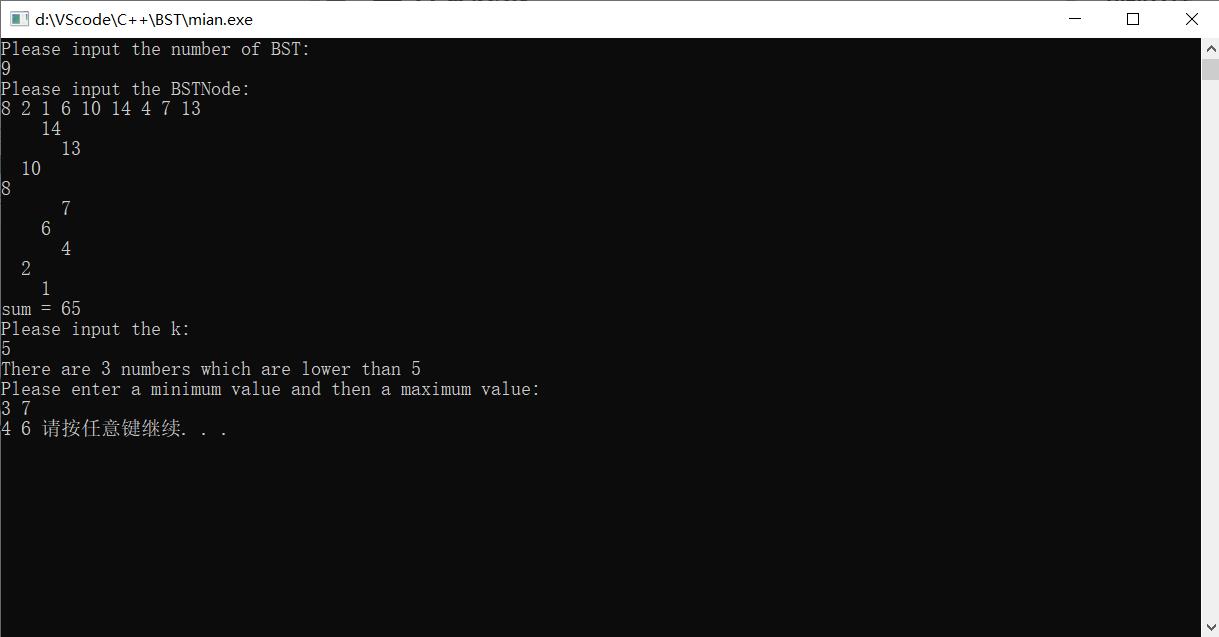C++二叉搜索树(BST)
Posted 桃陉
tags:
篇首语:本文由小常识网(cha138.com)小编为大家整理,主要介绍了C++二叉搜索树(BST)相关的知识,希望对你有一定的参考价值。
一.基本介绍
特征:
二叉搜索树,也被称为二叉查找树、有序二叉树或者排序二叉树。
∙ \\bullet ∙ 一般来说输入的第一个数作为根结点,当继续输入数时,小于根结点的放在根结点左边,大于根结点的放在根结点右边。
∙ \\bullet ∙ 不只是根结点,每个子节点也符合左小右大的规律。
∙ \\bullet ∙ 如下图所示,输入数据8、3、10、1、6、14、4、7、13,得到下面的二叉搜索树。

二叉查找树插入时间复杂度较低,为O(logn),查找时间复杂度最坏为O(n)。
下面我们来介绍BST的构成成分:
∙ \\bullet ∙ 首先我们需要实现两个类:一个是BSTNode类(节点类)、一个为BST类(二叉查找树类)。
∙ \\bullet ∙ BSTNode类含有节点值 it 、左节点指针 lc、右节点指针 rc等私有变量,取值修改值、取节点修改节点、判断节点是否为叶子结点等公有函数。
∙ \\bullet ∙ BST类含有根节点 root、节点个数 nodecount等私有变量,清空BST、插值、删除最小值、找到最小值、删除指定值、查找指定值、打印BST等函数。
∙ \\bullet ∙ 需要注意的是我们采用了泛型编程来实现BST,这样在实际应用中应用更广。
在主函数中我们还实现了求和、找出小于指定值的数、找出位于两数之间的数等操作函数。具体实现过程见下面的代码。
二.代码实现
分为三个文件:
BSTNode.h:
#ifndef _BSTNODE_H_
#define _BSTNODE_H_
#include<iostream>
using namespace std;
/*
采用泛型编程实现BST节点类,方便使用
*/
template<typename E> class BSTNode
{
private:
E it; //value
BSTNode *lc; //left node
BSTNode *rc; //right node
public:
//构造函数
BSTNode() {lc=rc=NULL;}
BSTNode(E e,BSTNode *l=NULL,BSTNode<E> *r=NULL){this->it=e;this->lc=l;this->rc=r;}
//析构函数
~BSTNode(){}
//取值
E& element() {return it;}
//修改值
void setElement(const E& e) {it=e;}
//取出左\\右结点
inline BSTNode* left() const {return lc;}
inline BSTNode* right() const {return rc;}
//修改左右结点
void setleft(BSTNode<E> *b) {lc=b;}
void setright(BSTNode<E> *b) {rc=b;}
//判断是否为叶结点
bool isLeaf() {return (lc==NULL)&&(rc==NULL);}
};
#endif
BST.h:
#include<iostream>
#include<cstdlib>
#include"BSTNode.h"
using namespace std;
template<typename E>
class BST
{
private:
//根结点
BSTNode<E>* root;
int nodecount; //结点个数
//清空BST树操作
void clearhelp(BSTNode<E>* root)
{
if(root==NULL) return ;
clearhelp(root->left());
clearhelp(root->right());
delete root;
}
//插入e到合适的位置
BSTNode<E>* inserthelp(BSTNode<E>* root,const E&e)
{
if(root==NULL) return new BSTNode<E>(e,NULL,NULL);
if(e<root->element()) root->setleft(inserthelp(root->left(),e));
else root->setright(inserthelp(root->right(),e));
return root;
}
//删除最小值,并将其他数排好序
BSTNode<E>* deletemin(BSTNode<E>* rt)
{
if(rt->left()==NULL) return rt->right();
else {
rt->setleft(deletemin(rt->left()));
return rt;
}
}
//获得最小值
BSTNode<E>* getmin(BSTNode<E>* rt)
{
if(rt->left()==NULL) return rt;
else return getmin(rt->left());
}
//删除指定值
BSTNode<E>* removehelp(BSTNode<E>* rt,const E& e)
{
if(rt==NULL) return NULL;
else if(e<rt->element()) rt->setleft(removehelp(rt->left(),e));
else if(e>rt->element()) rt->setright(removehelp(rt->right(),e));
else
{
BSTNode<E>* temp=rt;
if(rt->left()==NULL)
{
rt=rt->right();
delete temp;
}else if(rt->right()==NULL)
{
rt=rt->left();
delete temp;
} else
{
BSTNode<E>* temp=getmin(rt->right());
rt->setElement(temp->element());
rt->setright(deletemin(rt->right()));
delete temp;
}
}
return rt;
}
//寻找指定值
E findhelp(BSTNode<E>* root,const E&e) const
{
if (root==NULL) return NULL;
if(e<root->element()) return findhelp(root->left(),e);
else if(e>root->element()) return findhelp(root->right(),e);
else return root->element();
}
//打印BST树
void printhelp(BSTNode<E>* root,int level) const
{
if(root==NULL) return ;
printhelp(root->right(),level+1);
for(int i=0;i<level;i++)
cout<<" ";
cout<<root->element()<<"\\n";
printhelp(root->left(),level+1);
}
public:
BST(){root=NULL;nodecount=0;}
~BST(){clearhelp(root);}
BSTNode<E>* getRoot() {return this->root;}
void insert(const E& e)
{
root=inserthelp(root,e);
nodecount++;
}
E remove (const E&e)
{
E temp=findhelp(root,e);
if (temp!=NULL)
{
root=removehelp(root,e);
nodecount--;
}
return temp;
}
//删除根结点
E removeAny()
{
if(root!=NULL)
{
E temp=root->element();
root=rempvehelp(root,root->element());
nodecount--;
return temp;
}
else return NULL;
}
E find(const E&e) const {return findhelp(root,e);}
int size() {return nodecount;}
void print() const
{
if (root==NULL) cout<<"The BST is empty.\\n";
else printhelp(root,0);
}
};
main.cpp:
#include"BST.h"
#include"BSTNode.h"
#include<iostream>
#include<cstdlib>
using namespace std;
//求所有结点之和
int sum(BSTNode<int>* root,int &num)
{
if(root==NULL) return -1;
num+=root->element();
sum(root->left(),num);
sum(root->right(),num);
return num;
}
//寻找所以比指定值小的所有的数
int findSmallCount(BSTNode<int>* root,int k,int &count)
{
if(root==NULL) return 0;
if(k>=root->element()) count++;
findSmallCount(root->left(),k,count);
if(k<root->element()) return count;
findSmallCount(root->right(),k,count);
return count;
}
//寻找在两数之间的数
void print(BSTNode<int>* root,int min,int max)
{
if(root==NULL) return ;
print(root->left(),min,max);
if(root->element()<max && root->element()>min) cout<<root->element()<<" ";
print(root->right(),min,max);
}
int main()
{
int n=0;
cout<<"Please input the number of BST:"<<endl;
BST<int> bst;
cin>>n;
cout<<"Please input the BSTNode:"<<endl;
while(n)
{
int m=0;
cin>>m;
bst.insert(m);
n--;
}
//打印BST
bst.print();
int num=0;
BSTNode<int>* root=bst.getRoot();
cout<<"sum = "<<sum(root,num)<<endl;
int count=0;
int k=0;
cout<<"Please input the k:"<<endl;
cin>>k;
cout<<"There are "<<findSmallCount(root,k,count)<<" numbers which are lower than "<<k<<endl;
int min=0,max=0;
cout<<"Please enter a minimum value and then a maximum value:"<<endl;
cin>>min>>max;
print(root,min,max);
system("pause");
return 0;
}
三.结果展示

将打印出来的BST顺时针旋转90°就可以看到标准的BST,在主函数中依次实现了建树、打印树、求和、查找小于k的数的个数、查找位于两个数之间的数。
其他比如删除、查找等操作大家可以自行实现!
以上是关于C++二叉搜索树(BST)的主要内容,如果未能解决你的问题,请参考以下文章